Symptoms of pollen allergy (hay fever)
Pollen may cause hay fever, also called pollen allergy or pollinosis, to some people. These persons may then suffer from an itching congested and running nose, a sore nasal-throat cavity, sneezing, caughing, watery and sometimes bloodshot eyes and also perhaps a light thightness of the chest. Other symptoms include: headache, fatigue, inflammation of sinuses and throat.
| Medical aspects of hay fever |
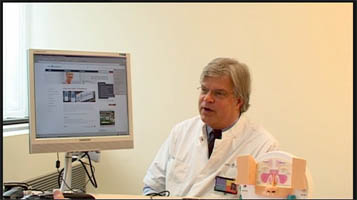 |
Links to a site with information movies on hayfever
Explanantions (in Dutch) about symptomes of hay fever
Cross-allergy (in Dutch)
IgE-tests (in Dutch)
Hooikoorts.tv channel (in Dutch) with lots of information on hay fever |
"
Allergy" can be defined as a
-Strong- specific reaction of the human body to exogenous molecules that may occur in the normal environment". "
Hay fever" is defined as a "
yearly returning seasonal affection due to allergy to certain airborne pollen grains".
The name "hay fever" arises from the many symptoms occuring during the massive release of grass pollen in the hay season. Hence, hay fever is not directly related to hay, but with pollen; the scientific name is "
Pollinosis". "Seasonal) Allergic Rhinitis" (SAR) refers to an inflammation of prepoundarily the nasal mucosa but is sometimes used for pollinosis as a whole. The allergic affection of eye mucosa is named "(Seasonal) Allergic Conjunctivitis" (SAC). The -not seasonal- symptoms can also be caused for example by house dust or fungi. Nowadays physicians prefer to speak of periodical (pollinosis) or persistent (house dust and such) allergic rhinitis or conjunctivitis. More than 25% of th epopulation suffers of an allergic rhinitis. In about half of all cases the manifestation is caused by pollen. The number of persons with allergy increases rapidly; it is expected that about 50% of coming generation will suffer from some kind of allergy.
Allergens
Heavily allergenic pollen
Hay fever is only provoked by wind pollinators: the risk to be in contact with pollen transfered by insects is low. It is a luck that only few airborne species are allergenic. In the Netherlands and Belgium the plants with the most allergenic pollen are (in decreasing order of importance): Grasses, Birches, Mugwort, Alders, Hazels, Plantains, but also Sorrels.
More about plants which pollen is allergenic, and about pollen counting and calendars and on current hay fever prognoses per country, region or town.
Classification of pollen allergens and cross-reactions
One does not become allergic for the entire pollen grains, but for certain proteins present in or around the pollen grains. These proteinscan been biochemically classified and get then a name composed from the first three letters ofthe genus of the plant which produces the pollen,followed by a number. The allergen Lol 1 is allergene nr 1 from the genus
Lolium (Rye Grass). Sometimes also the first letter of the species is added to the name: Lol p 1 is allergene nr 1 from
Lolium perenne (
Perennial Ryegrass).
Pollen grains usually carry several allergens that each separately may cause symptoms. An allergic reaction to a certain allergen that also occurs after contact with an allergen from another source is also called cross-reaction. Who is sensitive to pollen belonging to a certain genus, for example Birch pollen, is more likely to suffer also from pollen of other groups belonging to the Birch family, like Alders and Hazels: they carry allergens that are quite similar. Cross-reactions can also occur between allergens from completely different origin, like Birch pollen, apples and nuts.
Mechanisms behind pollinosis
Hay fever or pollinosis may arise when pollen in the air reaches the mucosa and proteins of the pollen surface, wall or cytoplasm, among which allergens, dissolve in the mucosal fluid. Then, the allergic reaction can begin. Two steps can be distinguished in this allergic reaction: the
sensibilization and the effector phase.
| Diagram Pollen Allergy |
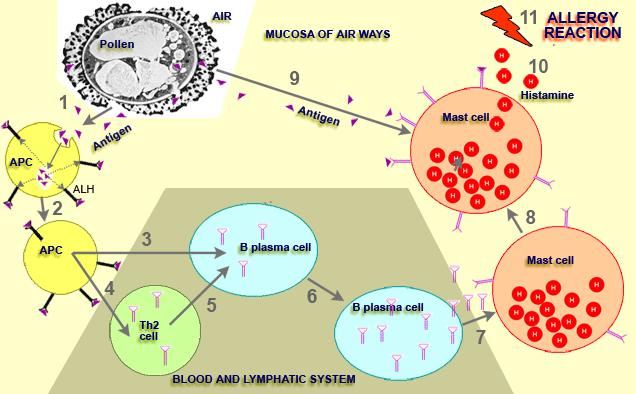 |
1. Pollen allergens (antigens) are released in the air and reach the air ways and so the mucosa
2. Once in the blood stream of the mucosa the antigens are taken up by cells of the immune system (Antigen-Presenting-Cells = APC), broken down into bits and bound to specific proteins called AHL to be "presented" at the cell surface.
3 and 4. These APCs stimultate B and Th2 cells to produce the antigen-binding protein
5. Th2 cell stimulates the B cell
6. to make even more antigen-binding protein
7. B cell in het blood plasma secretes antigen-binding protein (IgE)
8. By B cell secreted antigen-binding proteins bind to the surface of mast cells (also called mastocyte)
9. Therefore the mast cell become more sensitive to antigens
10. After the mast cell has bound antigens it produces vesicles with histamin and other hormones
10. The histamin is released and caused an allergic reaction
|
Sensibilization phase
During the sensibilization phase the allergens are taken up (engested by phagocytosis) by cells of the immune system, like macrophages and dendric cells. Next these cells (also named APC = antigen presenting cells) partly break down the entered allergens and "present" the remaining bits bound to certain proteins, the HLA's or Human Leukocyte Antigens, to the cell surface: the so-called antigen presentation. The antigens bound to HLA can now be recognized by T-cells which subsequently stimulate B-cells toproduce a specific antibody. B-cells can also be directly activated. en The most important antibody present in the blood is the IgG, but in the mucosa of mouth, nose and eyes the IgE is more common. It is assumed that the IgE gives protection against some parasitary infections, but nowadays it is better known because of its role in allergy. The IgE has the lowest concentration od all types of antibodies, for example 30 000 times lower than the blood IgG, but it can still react with a tiny quantity of allergens. The IgE in the mucosa is bound to the surface of so-called mastcells (van the German word "Mastzellen" for feeding cells, according to description by Paul Ehrlich).
Effector phase
When a sensibilized person comes in contact with the allergen, the effector phase is provoked.
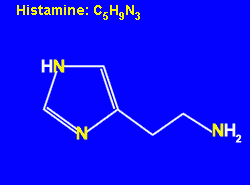
The allergen binds then to the allergen-specific IgE at the surface of the mastcells. In the mastcells numerous granula are present; these are vesicles filled with proteolytic (= proteins degradating) enzymes, heparine (prevents blood coagulation) and moreover the hormone Histamine. As a consequence of the binding of the allergen to the IgE at the surface of the cell the granula releasetheir contents in the surroundings, the so-called "degranulation". The effect can be usually sensed within 20 minutes: the early reaction. Especially the Histamine is responsible for the direct symptoms, it causes a burning feeling, itching and dilatation of the periphere blood capillaries. The reaction is similar to the one when the skin coms in contact with hairs of a Stinging Nettle: also those hairs contain Histamine (
Structure formula of the histamine molecule; the hormone Histamine consists of a ring of three Carbon and two Nitrogen atoms and of a side chain of two carbon atoms ending in a Nitrogen atom. The hormone is basic due to the presence of Nitrogen ). About six hours after the early reaction the late reaction occurs. This is a true inflammatory reaction caused by the hormones released at the beginning of the allergic reaction.
| Histamine: mast cells and hairs of Stinging Nettle |
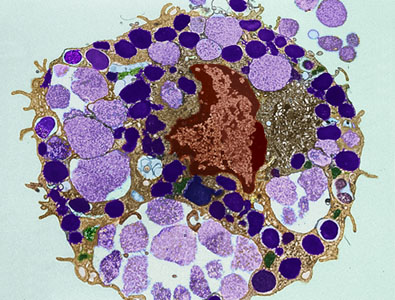 | 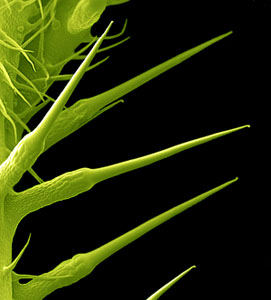 |
|
Colorized TEM-view of a degranulated mastcell from human mucosa. The nucleus is painted dark red, the mitochondria dark green, the cytoplasm brownish. The secretion vesicles or secretion granula (= grains) that contain a.o. the hormone Histamine are shown in blue. The cells degranulate, which means that they discharge the contents of the granula into their surroundings. Along with degranulation the dark vesicles swell and become grainy. | Green colorized SEM-views of nettle hairs of the Small Nettle (Urtica urens). They contains Histamine and provoke, luckily for a short time, the same burning and itching sense as with a serious hay fever attack. |
Prevention of hay fever
Allergies have complex reasons, in which both predisposition and environment play a role. Some persons may be predisposed to allergic reactions: allergies often "run" in certain families. The occurance of pollen (and other)allergies, is strongly enhanced by an unhealthy life style (e.g. smoking, consumption of alcohol and drugs) and air pollution (fine particles, nitrogen oxydes); but also an exaggerated hygiene during youth raises the risks to develop allergy, also being older. The nutritional pattern has possibly some (cross) effects as well. Regarding hay fever, the most evident remedial to prevent symptoms is to mind expose to the trigger, airborne pollen grains to which one is sensitive, by staying indoors or at least by refraining from having physical activity outside, especially on sunny and dry days. In this respect,
pollen calendars provide a most useful indication. Wearing (sun)glasses, a hat and certainly a mask (filter) in extreme cases also helps.
Treatment of hay fever
The treatment of hay fever mostly involves anti-histaminica, a blocker of histamine binding (see diagram here below).
| Treatment with anti-histamine |
 | Diagram of the working mechanism of antihistaminica. Antihistaminica bind to the Histamine receptors without causing any immune reaction. Then, the receptors being occupied, the Histamine can not bind anymore and the allergy effect is prevented |
When Histamine is released in the body of a sensibilized hay fever patient and these molecules binds to Histamine-receptors of mucosa cells, a cascade of reactions is engendered which leads to the typical inflammatory symptoms. Three types of Histamine receptors are present in man,: the H
1-, H
2- and H
3‑receptors. The symptoms related to hay fever are caused by binding of Histamine molecules to H
1‑receptors. These are present on the surface of mucosa cells in the throat, nose and eyes, and in smooth muscles of the capillaries, the bronchia, but also the bladder. De H
2‑receptors can be found in the digestive track, especially in the stomac. Through this receptor Histamine stimulates the release of gastric acid. The H
3‑receptor occurs only in the central nervous system, brain and spinal cord. Histamine has a stimulating effect; antagonists of the H
3‑receptor have a calming (= sedative) effect.
Antihistaminica are drugs that have the property to bind to Histamine-receptors without activating the immune system. Because the receptors are thus "occupied", Histamine can not bind to these ligands anymore and further allergic reactions are prevented. Antihistaminica in nose sprays or eye drops act rapidly and are very effective. For long-term conditions they are given as tablets,but then it takes a bit longer before they work. To treat hay fever without or with less adverse reactions on gastrointestinal or nervous system, like drowsiness, nowadays antihistaminica are available which specifically act on the H1‑receptors and thus have little side effects. Alcohol and antihistaminica reinforce each others effect, so don't use them together. Always take the instruction on the accompanying patient information leaflet into account, in particular regarding impairment of driving skills, and ask advise to your pharmacist or general practitioner.
Besides anti-histamines there exists nowadays other kinds of treatments (e.g. with steroids) and therapies (e.g. immunotherapy) immunotherapy or desensitization therapy. They are applicable to serious and long-lasting cases when anti-histamines fail to bring releave and will not be further discussed here.
Webpages and photographs:Jan Derksen and Elisabeth Pierson
Drawings: Jan Derksen
Web development: Remco Aalbers







